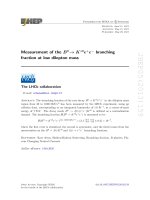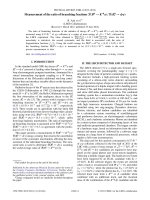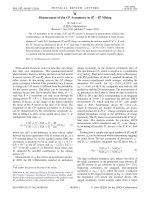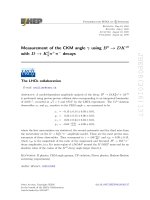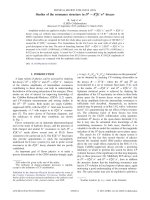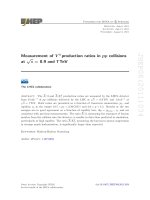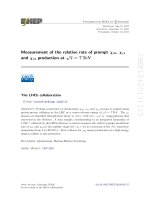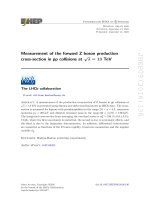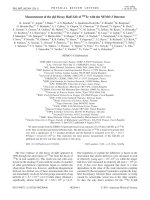DSpace at VNU: Measurement of the inclusive Φ cross-section in pp collisions at s=7 TeV
Bạn đang xem bản rút gọn của tài liệu. Xem và tải ngay bản đầy đủ của tài liệu tại đây (395.07 KB, 7 trang )
Physics Letters B 703 (2011) 267–273
Contents lists available at ScienceDirect
Physics Letters B
www.elsevier.com/locate/physletb
Measurement of the inclusive φ cross-section in pp collisions at
√
s = 7 TeV ✩
LHCb Collaboration
a r t i c l e
i n f o
Article history:
Received 21 July 2011
Received in revised form 8 August 2011
Accepted 9 August 2011
Available online 12 August 2011
Editor: W.-D. Schlatter
a b s t r a c t
The
√ cross-section for inclusive φ meson production in pp collisions at a centre-of-mass energy of
s = 7 TeV has been measured with the LHCb detector at the Large Hadron Collider. The differential
cross-section is measured as a function of the φ transverse momentum p T and rapidity y in the region
0.6 < p T < 5.0 GeV/c and 2.44 < y < 4.06. The cross-section for inclusive φ production in this kinematic
43
range is σ ( pp → φ X ) = 1758 ± 19(stat)+
−14 (syst) ± 182(scale) μb, where the first systematic uncertainty
depends on the p T and y region and the second is related to the overall scale. Predictions based on the
Pythia 6.4 generator underestimate the cross-section.
© 2011 CERN. Published by Elsevier B.V. All rights reserved.
1. Introduction
2. LHCb detector and data set
Two specific regimes can be distinguished in hadron production in pp collisions: the so-called hard regime at high transverse momenta, which can be described by perturbative QCD; and
the soft regime, which is described by phenomenological models. The underlying event in pp processes falls into the second
category. Therefore soft QCD interactions need careful study to
enable tuning of the models at a new centre-of-mass energy.
Strangeness production is an important ingredient of this effort.
Measurements of φ production have been reported by various experiments [1–7] in different collision types, for different centreof-mass energies and different kinematic coverage. LHCb is fully
instrumented in the forward region and thus yields unique results
complementary to previous experiments and to the other LHC experiments.
A measurement
√ of the inclusive differential φ cross-section in
pp collisions at s = 7 TeV is presented in this Letter. The analysis uses as kinematic variables the φ meson transverse momentum p T and the rapidity y = 12 ln[( E + p z )/( E − p z )] measured in
the pp centre-of-mass system.1 φ mesons are reconstructed using
the K+ K− decay mode and thus the selection relies strongly on
LHCb’s RICH (Ring Imaging Cherenkov) detectors for particle identification (PID) purposes. Their performance is determined from
data with a tag-and-probe approach. The measured cross-section
is compared to two different Monte Carlo (MC) predictions based
on Pythia 6.4 [8].
Designed for precise measurements of B meson decays, the
LHCb detector is a forward spectrometer with a polar angle coverage with respect to the beam line of approximately 15–300 mrad
in the horizontal bending plane, and 15–250 mrad in the vertical non-bending plane. The tracking system consists of the Vertex
Locator (VELO) surrounding the pp interaction region, a tracking
station upstream of the dipole magnet, and three tracking stations
downstream of the magnet.
Particles travelling from the interaction region to the downstream tracking stations are deflected by a dipole field of around
4 Tm, whose polarity can be switched. For this study, roughly
the same amount of data was taken with both magnet polarities.
The detector has a dedicated PID system that includes two Ring
Imaging Cherenkov detectors. RICH1 is installed in front of the
magnet and uses two radiators (Aerogel and C4 F10 ), and RICH2
is installed beyond the magnet, with a CF4 radiator. Combining
all radiators, the RICH system provides pion-kaon separation in a
momentum range up to 100 GeV/c. Downstream of the tracking
stations the detector has a calorimeter system, consisting of the
Scintillating Pad Detector (SPD), a preshower, the electromagnetic
and the hadronic calorimeter, and five muon stations. Details of
the LHCb detector can be found in Ref. [9].
The study described in this note is based on an integrated luminosity of 14.7 nb−1 of pp collisions collected in May 2010, where
the instantaneous luminosity was low.
The trigger system consists of a hardware based first level trigger and a high level trigger (HLT) implemented in software. The
first level trigger was in pass-through mode, whereas at least one
track, reconstructed with VELO information, was required to be
found by the HLT. On Monte Carlo simulated events, this trigger
✩
© CERN, for the benefit of the LHCb Collaboration.
The detector reference frame is a right handed coordinate system with + z
pointing downstream from the interaction point in the direction of the spectrometer and the + y axis pointing upwards.
1
0370-2693/ © 2011 CERN. Published by Elsevier B.V. All rights reserved.
doi:10.1016/j.physletb.2011.08.017
268
LHCb Collaboration / Physics Letters B 703 (2011) 267–273
Fig. 1. Fit to the tag (left) and the probe (right) sample in the bin 0.6 < p T < 0.8 GeV/c, 3.34 < y < 3.52 for one of the two magnet polarities. Shown are the data points,
the fit result (thick solid line) as well as the signal (thin solid line) and the background component (dash-dotted line).
configuration is found to be 100% efficient for reconstructed φ candidates. However, to limit the acquisition rate, a prescaling was
applied.
The luminosity was measured by two van der Meer scans [10]
and a novel method measuring the beam geometry with the VELO,
as described in Ref. [11]. Both methods rely on the measurement
of the beam currents as well as the beam profile determination.
Using these results, the absolute luminosity scale is determined,
using the method described in Ref. [12], with a 3.5% uncertainty,
dominated by the knowledge of the beam currents. The instantaneous luminosity determination is then based on a continuous
recording of the hit rate in the SPD, which has been normalized
to the absolute luminosity scale. The probability for multiple pp
collisions per bunch-crossing was negligibly low in the data taking
period considered here.
As the RICH detectors are calibrated separately for the two
magnet polarities, the measurement is carried out separately for
each sample before combining them for the final result.
Trigger and reconstruction efficiencies are determined using a
sample of 1.25 · 108 simulated minimum bias events. These have
been produced in the LHCb MC setting, which is based on a custom
Pythia tune for the description of pp collisions, while particle decays are generally handled by EvtGen [13]. The total minimum bias
cross-section in LHCb MC simulation is 91.05 mb, composed of the
following Pythia process types: 48.80 mb inelastic-non-diffractive,
2 × 6.84 mb single diffractive, 9.19 mb double diffractive and
19.28 mb elastic. Details on the LHCb MC setting can be found
in Ref. [14].
3. Data selection and efficiencies
Two oppositely charged tracks, each of which are required to
have hits in both the VELO and the main tracking system, are combined to form φ → K + K − candidates. The RICH system provides
kaon-pion separation for reconstructed tracks, which is crucial for
the inclusive φ production analysis. As a first step, at least one
kaon is required to pass a tight cut based on the RICH response
during the selection. In a second step, both kaons have to pass
this criterion. The samples of φ candidates passing the cuts of the
first and second steps are referred to as “tag” and “probe” samples, respectively. They are used to measure the PID efficiency in
the selection as explained below. The reconstructed K + K − mass
is required to be between 995 MeV/c 2 and 1045 MeV/c 2 in both
samples.
No cut designed to discriminate prompt and non-prompt φ
mesons is applied in the selection, so the measurement includes
both. However, due to the high minimum bias cross-section compared to charm or beauty production, the non-prompt contribution
is small; in MC simulation it is found to be 1.6%.
The region of interest 0.6 < p T < 5.0 GeV/c and 2.44 < y <
4.06 is divided into 9 bins in y and 12 bins in p T . The differential
cross-section per bin in p T and y is determined by the equation:
d2 σ
d y dp T
=
1
y
pT
·
N tag
L · εreco · εpid · B(φ → K+ K− )
,
(1)
where N tag is the number of reconstructed φ candidates in the tag
sample, L the integrated luminosity and B (φ → K+ K− ) = (49.2 ±
0.6)% the branching fraction taken from Ref. [15]. The selection
efficiency is split up into two parts in Eq. (1): reconstruction εreco ,
including the geometrical acceptance, and the PID efficiency εpid .
Both efficiencies are a function of the p T and y values of the φ
meson and thus determined separately for each bin.
In the centre of the kinematic region, the reconstruction efficiency is of the order of 65–70%. It drops to 30–40% with low
transverse momenta and high or low rapidity values. The PID efficiency is above 95% in the centre of the kinematic region and
drops to 60–70% at the edges of the considered kinematic region.
The reconstruction efficiency is determined from simulation. To
limit the MC dependence, the PID efficiency is determined from
data using the tag-and-probe method: in the φ selection, at least
one of the two kaons is required to pass the PID criterion. The
number of φ candidates passing this requirement is given by N tag .
In a subsequent step, both kaons must pass the PID criterion. The
number of φ candidates passing this step is given by N probe . The
efficiency εpid that at least one of the two kaons from a φ candidate fulfils the kaon PID requirement for each bin is thus given
by:
εpid = 1 −
N tag − N probe
N tag + N probe
2
.
(2)
This formula is valid only if the efficiencies that the two kaons
satisfy the requirements are independent. However, owing to the
variation of the RICH efficiency with track multiplicity, correlations between the values of the discriminant variable of the
RICH are observed and are accounted for in the systematic uncertainty.
4. Signal extraction
Simultaneous maximum likelihood fits to the φ candidate mass
distributions on the tag and the probe samples are performed
LHCb Collaboration / Physics Letters B 703 (2011) 267–273
269
Table 1
Summary of relative systematic uncertainties
that are common to all bins.
Source
(%)
Tracking efficiency
Luminosity (normalization)
Track multiplicity
Fit systematics
MC association
Doubly identified candidates
Branching fraction
Bin migration
Material interactions
Total
8
4
3
3
2
2
1
1
1
10
Table 2
Binned differential cross-section, in μb/MeV/c, as function of p T (GeV/c) and y.
The statistical and the bin-dependent systematic uncertainties are quoted. There is
an additional bin-independent uncertainty of 10% related to the normalization (Table 1).
pT /y
2.44–2.62
2.62–2.80
2.80–2.98
0.6–0.8
0.076
1.001 ± 0.140+
−0.026
0.081
0.853 ± 0.114+
−0.022
0.093
1.069 ± 0.108+
−0.027
0.089
0.758 ± 0.043+
−0.009
0.063
0.776 ± 0.038+
−0.009
0.042
0.795 ± 0.026+
−0.009
0.8–1.0
1.0–1.2
1.2–1.4
1.4–1.6
1.6–1.8
1.8–2.0
2.0–2.4
2.4–2.8
2.8–3.2
3.2–4.0
Fig. 2. Inclusive differential φ production cross-section as a function of p T (top)
and y (bottom), measured with data (points), and compared to the LHCb default
MC tuning (solid line) and Perugia 0 tuning (dashed line). The error bars represent
the statistical uncertainty, the braces show the bin dependent systematic errors, the
overall scale uncertainty from Table 1 is not plotted. The lower parts of the plots
show the ratio data cross-section over Monte Carlo cross-section. Error bars in the
ratio plots show statistical uncertainties only.
4.0–5.0
f sig =
1
(m − m0 )2 + 14 Γ 2 /c 4
⊗ exp −
1m2
2
σ2
f bkg = 1 − exp c 1 · (m − c 2 )
containing two free parameters.
The fitted φ mass and the Gaussian width σ are common parameters for both tag and probe sample, while the Breit–Wigner
width Γ is fixed to the value 4.26 MeV taken from Ref. [15]. In
Fig. 1, fit results to the two samples in a given p T / y bin are shown
for illustration purposes.
5. Systematic uncertainties
0.015
0.409 ± 0.018+
−0.007
0.009
0.276 ± 0.012+
−0.005
0.003
0.201 ± 0.007+
−0.003
0.002
0.111 ± 0.004+
−0.002
0.002
0.063 ± 0.003+
−0.002
0.001
0.034 ± 0.001+
−0.001
0.000
0.011 ± 0.001+
−0.000
3.16–3.34
3.34–3.52
0.027
1.060 ± 0.092+
−0.043
0.029
1.131 ± 0.146+
−0.176
0.031
0.818 ± 0.034+
−0.009
+0.016
0.648 ± 0.026−0.008
0.013
0.484 ± 0.019+
−0.006
+0.008
0.408 ± 0.016−0.007
0.006
0.320 ± 0.014+
−0.007
+0.004
0.206 ± 0.006−0.004
0.003
0.109 ± 0.004+
−0.002
+0.002
0.065 ± 0.003−0.002
0.001
0.031 ± 0.001+
−0.001
+0.001
0.010 ± 0.001−0.000
0.010
0.851 ± 0.033+
−0.010
+0.009
0.693 ± 0.026−0.008
0.009
0.499 ± 0.018+
−0.007
+0.008
0.382 ± 0.015−0.006
0.009
0.308 ± 0.008+
−0.006
+0.006
0.194 ± 0.006−0.003
0.003
0.106 ± 0.004+
−0.002
+0.002
0.057 ± 0.003−0.001
0.001
0.029 ± 0.001+
−0.001
+0.000
0.010 ± 0.001−0.000
0.009
0.781 ± 0.031+
−0.009
0.8–1.0
1.0–1.2
1.4–1.6
1.6–1.8
1.8–2.0
2.0–2.4
2.4–2.8
3.2–4.0
0.6–0.8
0.8–1.0
1.0–1.2
1.2–1.4
1.4–1.6
1.6–1.8
1.8–2.0
2.0–2.4
2.4–2.8
The uncertainties in this analysis are dominated by systematic contributions, divided into the ones which are common to all
bins and the ones which vary from bin to bin. The former are
0.023
0.521 ± 0.022+
−0.008
0.058
1.171 ± 0.100+
−0.029
pT /y
(4)
0.024
0.604 ± 0.026+
−0.008
2.98–3.16
4.0–5.0
while the background shape is described by
0.049
0.627 ± 0.028+
−0.008
+0.033
0.511 ± 0.022−0.008
0.021
0.381 ± 0.017+
−0.007
+0.014
0.323 ± 0.015−0.007
0.006
0.192 ± 0.007+
−0.003
+0.002
0.112 ± 0.005−0.003
0.002
0.069 ± 0.003+
−0.002
+0.001
0.038 ± 0.002−0.001
0.001
0.014 ± 0.001+
−0.000
0.053
0.819 ± 0.079+
−0.012
pT /y
2.8–3.2
(3)
0.067
0.648 ± 0.033+
−0.009
+0.037
0.469 ± 0.023−0.008
0.039
0.422 ± 0.020+
−0.008
+0.027
0.334 ± 0.016−0.007
0.010
0.209 ± 0.008+
−0.004
+0.003
0.127 ± 0.005−0.003
0.002
0.078 ± 0.004+
−0.002
+0.001
0.040 ± 0.002−0.001
0.001
0.014 ± 0.001+
−0.001
0.074
0.797 ± 0.084+
−0.012
0.6–0.8
1.2–1.4
in each bin of p T and y to extract the signal yields. The number of reconstructed candidates without PID requirements N reco =
N tag /εpid is a free parameter in the fit. A Breit–Wigner distribution
convolved with a Gaussian resolution function is used to describe
the signal shape
0.129
0.959 ± 0.112+
−0.015
2.8–3.2
3.2–4.0
4.0–5.0
0.049
1.032 ± 0.080+
−0.015
0.014
0.862 ± 0.080+
−0.013
0.018
1.170 ± 0.082+
−0.058
0.011
0.661 ± 0.023+
−0.008
0.013
0.470 ± 0.017+
−0.006
0.009
0.348 ± 0.013+
−0.005
0.009
0.255 ± 0.010+
−0.004
0.005
0.169 ± 0.005+
−0.003
0.005
0.106 ± 0.004+
−0.002
0.003
0.053 ± 0.003+
−0.001
0.001
0.025 ± 0.002+
−0.001
0.000
0.009 ± 0.001+
−0.000
3.52–3.70
3.70–3.88
3.88–4.06
0.034
1.341 ± 0.158+
−0.207
+0.013
0.816 ± 0.075−0.035
0.010
0.785 ± 0.032+
−0.012
+0.012
0.609 ± 0.023−0.008
0.016
0.484 ± 0.018+
−0.007
+0.008
0.336 ± 0.013−0.006
0.006
0.231 ± 0.010+
−0.004
+0.007
0.164 ± 0.005−0.003
0.004
0.082 ± 0.002+
−0.002
+0.004
0.059 ± 0.003−0.002
0.001
0.022 ± 0.001+
−0.001
+0.001
0.008 ± 0.001−0.000
0.030
1.164 ± 0.157+
−0.065
+0.018
1.065 ± 0.075−0.059
0.010
0.690 ± 0.031+
−0.011
+0.010
0.561 ± 0.022−0.008
0.011
0.433 ± 0.017+
−0.007
+0.011
0.315 ± 0.014−0.006
0.009
0.228 ± 0.011+
−0.005
+0.006
0.140 ± 0.005−0.002
0.003
0.078 ± 0.004+
−0.002
+0.002
0.049 ± 0.003−0.001
0.002
0.019 ± 0.001+
−0.000
+0.001
0.007 ± 0.001−0.000
0.120
1.341 ± 0.193+
−0.036
0.018
0.975 ± 0.115+
−0.070
0.013
0.760 ± 0.039+
−0.039
0.012
0.531 ± 0.027+
−0.010
0.016
0.409 ± 0.021+
−0.008
0.011
0.279 ± 0.014+
−0.006
0.007
0.213 ± 0.011+
−0.005
0.003
0.131 ± 0.006+
−0.003
0.004
0.070 ± 0.004+
−0.002
0.006
0.039 ± 0.003+
−0.001
0.003
0.022 ± 0.002+
−0.001
0.000
0.007 ± 0.002+
−0.002
270
LHCb Collaboration / Physics Letters B 703 (2011) 267–273
summarized in Table 1, whereas the latter are plotted with the
data in Fig. 2 and listed in Table 2. The bin-dependent uncertainties consist of the reconstruction efficiency uncertainty due to the
limited simulation sample size and to the modelling of a diffractive contribution, as well as the uncertainty of the tag-and-probe
PID determination due to correlations. The combined uncertainties
contribute 3–7% for the statistically dominant bins.
The largest shared systematics are the uncertainty on the tracking efficiencies, which have been discussed in Ref. [16], and the
luminosity normalization. The track multiplicity in data is higher
than in the simulation. Studies of the track multiplicity dependence of the reconstruction efficiency result in an uncertainty of
3% due to this multiplicity difference.
Two major effects contribute to the uncertainty due to the fit
procedure. Fixing the Gaussian width to the same value on tagand-probe sample introduces only a 1% systematic uncertainty,
since the distribution is dominated by the Breit–Wigner width.
A larger systematic effect (2–3%) is observed when varying the
mass range of the fit, which results in a total uncertainty of 3%.
In the simulation, the reconstructed track is required to match
the true generated track to determine the reconstruction efficiency.
A 2% uncertainty is assigned due to this procedure. A small fraction of doubly identified candidates is found: it is possible that
the detector hits from one particle are reconstructed as more than
one track. The rate difference of these doubly identified candidates
between data and simulation is found to be 2%, which is the systematic uncertainty assigned due to this effect. The φ → K + K −
branching fraction contributes a 1% systematic uncertainty. Migration of candidates between different bins due to resolution effects is found to be small, and is accounted for by assigning a
1% uncertainty. Uncertainties from the modelling of the material
budget and the material interaction cross-section are estimated to
be 1%.
6. Results
The cross-sections determined with the two magnet polarities
agree within their statistical uncertainties. All results given here
are unweighted averages of the two samples. Comparisons to simulation samples generated with two different Pythia tunings are
made, namely Perugia 0 [17] and the LHCb default Monte Carlo
tuning.
The integrated cross-section in the region 0.6 < p T < 5.0 GeV/c
and 2.44 < y < 4.06 is
43
σ ( pp → φ X ) = 1758 ± 19(stat)+
−14 (syst) ± 182(scale) μb,
where the first systematic uncertainty arises from the bin-dependent contribution, while the second one is the common systematic
uncertainty, as described in Section 5. The differential cross-section
values are given in Table 2 and projections on the y and p T axes
within the same kinematic region are shown in Fig. 2.
The simulations underestimate the measured φ production in
the considered kinematic region by a factor 1.43 ± 0.15 (LHCb
MC) and 2.06 ± 0.22 (Perugia 0). Additionally, the shape of the
p T spectrum and the slope in the y spectrum differ between
the data and the simulation (see Fig. 2). Fitting a straight line
dσ = a · y + b to the y spectrum, the slope is a = −44 ± 27 μb
dy
on data, but a = −181 ± 2 μb for the default LHCb MC tuning and
a = −149 ± 3 μb for the Perugia 0 tuning. Uncertainties given on a
are statistical only.
The mean p T in the range 0.6 < p T < 5.0 GeV/c is 1.24 ±
0.01 GeV/c (data, stat. error only), 1.077 GeV/c (LHCb MC) and
1.238 GeV/c (Perugia 0 MC).
7. Conclusions
A study of inclusive φ production in pp collisions at a centreof-mass energy of 7 TeV at the Large Hadron Collider is reported.
The differential cross-section as a function of p T and y measured in the range 0.6 < p T < 5.0 GeV/c and 2.44 < y < 4.06 is
43
σ ( pp → φ X ) = 1758 ± 19(stat)+
−14 (syst) ± 182(scale) μb, where the
first systematic uncertainty depends on the p T and y scale and
the second is related to the overall scale. Predictions based on the
Pythia 6.4 generator underestimate the cross-section.
Acknowledgements
We express our gratitude to our colleagues in the CERN accelerator departments for the excellent performance of the LHC.
We thank the technical and administrative staff at CERN and at
the LHCb institutes, and acknowledge support from the National
Agencies: CAPES, CNPq, FAPERJ and FINEP (Brazil); CERN; NSFC
(China); CNRS/IN2P3 (France); BMBF, DFG, HGF and MPG (Germany); SFI (Ireland); INFN (Italy); FOM and NWO (Netherlands);
SCSR (Poland); ANCS (Romania); MinES of Russia and Rosatom
(Russia); MICINN, XUNGAL and GENCAT (Spain); SNSF and SER
(Switzerland); NAS Ukraine (Ukraine); STFC (United Kingdom); NSF
(USA). We also acknowledge the support received from the ERC under FP7 and the Région Auvergne.
Open access
This article is published Open Access at sciencedirect.com. It
is distributed under the terms of the Creative Commons Attribution License 3.0, which permits unrestricted use, distribution, and
reproduction in any medium, provided the original authors and
source are credited.
References
[1]
[2]
[3]
[4]
[5]
[6]
[7]
[8]
[9]
[10]
[11]
[12]
[13]
[14]
[15]
[16]
[17]
K.J. Anderson, et al., Phys. Rev. Lett. 37 (13) (1976) 799.
ACCMOR Collaboration, C. Daum, et al., Nucl. Phys. B 186 (2) (1981) 205.
E735 Collaboration, T. Alexopoulos, et al., Z. Phys. C 67 (1995) 411.
HERA-B Collaboration, I. Abt, et al., Eur. Phys. J. C 50 (2007) 315.
ZEUS Collaboration, S. Chekanov, et al., Phys. Lett. B 553 (2003) 141, hepex/0211025.
ALICE Collaboration, K. Aamodt, et al., Eur. Phys. J. C 71 (2011) 1594, arXiv:
1012.3257.
PHENIX Collaboration, M. Naglis, Nucl. Phys. A 830 (2009) 757c, arXiv:
0907.4461.
T. Sjöstrand, et al., JHEP 0605 (2006) 26.
LHCb Collaboration, A.A. Alves Jr., et al., JINST 3 (2008) S08005.
S. van der Meer, Calibration of the effective beam height in the ISR, ISR-PO/6831, 1986.
M. Ferro-Luzzi, Nucl. Instrum. Meth. A 553 (2005) 388.
LHCb Collaboration, R. Aaij, et al., Phys. Lett. B 693 (2) (2010) 69,
arXiv:1008.3105.
D.J. Lange, Nucl. Instrum. Meth. A 462 (2001) 152.
I. Belyaev, et al., Nuclear Science Symposium Conference Record (NSS/MIC)
(2010) 1155, />Particle Data Group, C. Amsler, et al., Phys. Lett. B 667 (2008) 1.
LHCb Collaboration, R. Aaij, et al., Phys. Lett. B 694 (3) (2010) 209, arXiv:
1009.2731.
P.Z. Skands, Phys. Rev. D 82 (2010) 074018.
LHCb Collaboration / Physics Letters B 703 (2011) 267–273
271
LHCb Collaboration
R. Aaij 23 , B. Adeva 36 , M. Adinolfi 42 , C. Adrover 6 , A. Affolder 48 , Z. Ajaltouni 5 , J. Albrecht 37 ,
F. Alessio 6,37 , M. Alexander 47 , G. Alkhazov 29 , P. Alvarez Cartelle 36 , A.A. Alves Jr. 22 , S. Amato 2 ,
Y. Amhis 38 , J. Anderson 39 , R.B. Appleby 50 , O. Aquines Gutierrez 10 , L. Arrabito 53 , A. Artamonov 34 ,
M. Artuso 52,37 , E. Aslanides 6 , G. Auriemma 22,m , S. Bachmann 11 , J.J. Back 44 , D.S. Bailey 50 ,
V. Balagura 30,37 , W. Baldini 16 , R.J. Barlow 50 , C. Barschel 37 , S. Barsuk 7 , W. Barter 43 , A. Bates 47 ,
C. Bauer 10 , Th. Bauer 23 , A. Bay 38 , I. Bediaga 1 , K. Belous 34 , I. Belyaev 30,37 , E. Ben-Haim 8 ,
M. Benayoun 8 , G. Bencivenni 18 , S. Benson 46 , J. Benton 42 , R. Bernet 39 , M.-O. Bettler 17,37 ,
M. van Beuzekom 23 , A. Bien 11 , S. Bifani 12 , A. Bizzeti 17,h , P.M. Bjørnstad 50 , T. Blake 49 , F. Blanc 38 ,
C. Blanks 49 , J. Blouw 11 , S. Blusk 52 , A. Bobrov 33 , V. Bocci 22 , A. Bondar 33 , N. Bondar 29 , W. Bonivento 15 ,
S. Borghi 47 , A. Borgia 52 , T.J.V. Bowcock 48 , C. Bozzi 16 , T. Brambach 9 , J. van den Brand 24 , J. Bressieux 38 ,
D. Brett 50 , S. Brisbane 51 , M. Britsch 10 , T. Britton 52 , N.H. Brook 42 , A. Büchler-Germann 39 , A. Bursche 39 ,
J. Buytaert 37 , S. Cadeddu 15 , J.M. Caicedo Carvajal 37 , O. Callot 7 , M. Calvi 20,j , M. Calvo Gomez 35,n ,
A. Camboni 35 , P. Campana 18,37 , A. Carbone 14 , G. Carboni 21,k , R. Cardinale 19,i , A. Cardini 15 , L. Carson 36 ,
K. Carvalho Akiba 23 , G. Casse 48 , M. Cattaneo 37 , M. Charles 51 , Ph. Charpentier 37 , N. Chiapolini 39 ,
X. Cid Vidal 36 , P.E.L. Clarke 46 , M. Clemencic 37 , H.V. Cliff 43 , J. Closier 37 , C. Coca 28 , V. Coco 23 , J. Cogan 6 ,
P. Collins 37 , F. Constantin 28 , G. Conti 38 , A. Contu 51 , A. Cook 42 , M. Coombes 42 , G. Corti 37 ,
G.A. Cowan 38 , R. Currie 46 , B. D’Almagne 7 , C. D’Ambrosio 37 , P. David 8 , I. De Bonis 4 , S. De Capua 21,k ,
M. De Cian 39 , F. De Lorenzi 12 , J.M. De Miranda 1 , L. De Paula 2 , P. De Simone 18 , D. Decamp 4 ,
M. Deckenhoff 9 , H. Degaudenzi 38,37 , M. Deissenroth 11 , L. Del Buono 8 , C. Deplano 15 , O. Deschamps 5 ,
F. Dettori 15,d , J. Dickens 43 , H. Dijkstra 37 , P. Diniz Batista 1 , D. Dossett 44 , A. Dovbnya 40 , F. Dupertuis 38 ,
R. Dzhelyadin 34 , C. Eames 49 , S. Easo 45 , U. Egede 49 , V. Egorychev 30 , S. Eidelman 33 , D. van Eijk 23 ,
F. Eisele 11 , S. Eisenhardt 46 , R. Ekelhof 9 , L. Eklund 47 , Ch. Elsasser 39 , D.G. d’Enterria 35,o ,
D. Esperante Pereira 36 , L. Estève 43 , A. Falabella 16,e , E. Fanchini 20,j , C. Färber 11 , G. Fardell 46 ,
C. Farinelli 23 , S. Farry 12 , V. Fave 38 , V. Fernandez Albor 36 , M. Ferro-Luzzi 37 , S. Filippov 32 ,
C. Fitzpatrick 46 , M. Fontana 10 , F. Fontanelli 19,i , R. Forty 37 , M. Frank 37 , C. Frei 37 , M. Frosini 17,37,f ,
S. Furcas 20 , A. Gallas Torreira 36 , D. Galli 14,c , M. Gandelman 2 , P. Gandini 51 , Y. Gao 3 , J.-C. Garnier 37 ,
J. Garofoli 52 , J. Garra Tico 43 , L. Garrido 35 , C. Gaspar 37 , N. Gauvin 38 , M. Gersabeck 37 , T. Gershon 44 ,
Ph. Ghez 4 , V. Gibson 43 , V.V. Gligorov 37 , C. Göbel 54 , D. Golubkov 30 , A. Golutvin 49,30,37 , A. Gomes 2 ,
H. Gordon 51 , M. Grabalosa Gándara 35 , R. Graciani Diaz 35 , L.A. Granado Cardoso 37 , E. Graugés 35 ,
G. Graziani 17 , A. Grecu 28 , S. Gregson 43 , B. Gui 52 , E. Gushchin 32 , Yu. Guz 34 , T. Gys 37 , G. Haefeli 38 ,
C. Haen 37 , S.C. Haines 43 , T. Hampson 42 , S. Hansmann-Menzemer 11 , R. Harji 49 , N. Harnew 51 ,
J. Harrison 50 , P.F. Harrison 44 , J. He 7 , V. Heijne 23 , K. Hennessy 48 , P. Henrard 5 , J.A. Hernando Morata 36 ,
E. van Herwijnen 37 , W. Hofmann 10 , K. Holubyev 11 , P. Hopchev 4 , W. Hulsbergen 23 , P. Hunt 51 , T. Huse 48 ,
R.S. Huston 12 , D. Hutchcroft 48 , D. Hynds 47 , V. Iakovenko 41 , P. Ilten 12 , J. Imong 42 , R. Jacobsson 37 ,
A. Jaeger 11 , M. Jahjah Hussein 5 , E. Jans 23 , F. Jansen 23 , P. Jaton 38 , B. Jean-Marie 7 , F. Jing 3 , M. John 51 ,
D. Johnson 51 , C.R. Jones 43 , B. Jost 37 , S. Kandybei 40 , M. Karacson 37 , T.M. Karbach 9 , J. Keaveney 12 ,
U. Kerzel 37 , T. Ketel 24 , A. Keune 38 , B. Khanji 6 , Y.M. Kim 46 , M. Knecht 38 , S. Koblitz 37 , P. Koppenburg 23 ,
A. Kozlinskiy 23 , L. Kravchuk 32 , K. Kreplin 11 , G. Krocker 11 , P. Krokovny 11 , F. Kruse 9 , K. Kruzelecki 37 ,
M. Kucharczyk 20,25 , S. Kukulak 25 , R. Kumar 14,37 , T. Kvaratskheliya 30,37 , V.N. La Thi 38 , D. Lacarrere 37 ,
G. Lafferty 50 , A. Lai 15 , D. Lambert 46 , R.W. Lambert 37 , E. Lanciotti 37 , G. Lanfranchi 18 , C. Langenbruch 11 ,
T. Latham 44 , R. Le Gac 6 , J. van Leerdam 23 , J.-P. Lees 4 , R. Lefèvre 5 , A. Leflat 31,37 , J. Lefrançois 7 ,
O. Leroy 6 , T. Lesiak 25 , L. Li 3 , Y.Y. Li 43 , L. Li Gioi 5 , M. Lieng 9 , R. Lindner 37 , C. Linn 11 , B. Liu 3 , G. Liu 37 ,
J.H. Lopes 2 , E. Lopez Asamar 35 , N. Lopez-March 38 , J. Luisier 38 , F. Machefert 7 , I.V. Machikhiliyan 4,30 ,
F. Maciuc 10 , O. Maev 29,37 , J. Magnin 1 , S. Malde 51 , R.M.D. Mamunur 37 , G. Manca 15,d , G. Mancinelli 6 ,
N. Mangiafave 43 , U. Marconi 14 , R. Märki 38 , J. Marks 11 , G. Martellotti 22 , A. Martens 7 , L. Martin 51 ,
A. Martín Sánchez 7 , D. Martinez Santos 37 , A. Massafferri 1 , Z. Mathe 12 , C. Matteuzzi 20 , M. Matveev 29 ,
E. Maurice 6 , B. Maynard 52 , A. Mazurov 32,16,37 , G. McGregor 50 , R. McNulty 12 , C. Mclean 14 ,
M. Meissner 11 , M. Merk 23 , J. Merkel 9 , R. Messi 21,k , S. Miglioranzi 37 , D.A. Milanes 13,37 , M.-N. Minard 4 ,
S. Monteil 5 , D. Moran 12 , P. Morawski 25 , J.V. Morris 45 , R. Mountain 52 , I. Mous 23 , F. Muheim 46 ,
K. Müller 39 , R. Muresan 28,38 , B. Muryn 26 , M. Musy 35 , P. Naik 42 , T. Nakada 38 , R. Nandakumar 45 ,
272
LHCb Collaboration / Physics Letters B 703 (2011) 267–273
J. Nardulli 45 , I. Nasteva 1 , M. Nedos 9 , M. Needham 46 , N. Neufeld 37 , C. Nguyen-Mau 38,p , M. Nicol 7 ,
S. Nies 9 , V. Niess 5 , N. Nikitin 31 , A. Oblakowska-Mucha 26 , V. Obraztsov 34 , S. Oggero 23 , S. Ogilvy 47 ,
O. Okhrimenko 41 , R. Oldeman 15,d , M. Orlandea 28 , J.M. Otalora Goicochea 2 , B. Pal 52 , J. Palacios 39 ,
M. Palutan 18 , J. Panman 37 , A. Papanestis 45 , M. Pappagallo 13,b , C. Parkes 47,37 , C.J. Parkinson 49 ,
G. Passaleva 17 , G.D. Patel 48 , M. Patel 49 , S.K. Paterson 49 , G.N. Patrick 45 , C. Patrignani 19,i ,
C. Pavel-Nicorescu 28 , A. Pazos Alvarez 36 , A. Pellegrino 23 , G. Penso 22,l , M. Pepe Altarelli 37 ,
S. Perazzini 14,c , D.L. Perego 20,j , E. Perez Trigo 36 , A. Pérez-Calero Yzquierdo 35 , P. Perret 5 ,
M. Perrin-Terrin 6 , G. Pessina 20 , A. Petrella 16,37 , A. Petrolini 19,i , B. Pie Valls 35 , B. Pietrzyk 4 , T. Pilar 44 ,
D. Pinci 22 , R. Plackett 47 , S. Playfer 46 , M. Plo Casasus 36 , G. Polok 25 , A. Poluektov 44,33 , E. Polycarpo 2 ,
D. Popov 10 , B. Popovici 28 , C. Potterat 35 , A. Powell 51 , T. du Pree 23 , J. Prisciandaro 38 , V. Pugatch 41 ,
A. Puig Navarro 35 , W. Qian 52 , J.H. Rademacker 42 , B. Rakotomiaramanana 38 , I. Raniuk 40 , G. Raven 24 ,
S. Redford 51 , M.M. Reid 44 , A.C. dos Reis 1 , S. Ricciardi 45 , K. Rinnert 48 , D.A. Roa Romero 5 , P. Robbe 7 ,
E. Rodrigues 47 , F. Rodrigues 2 , P. Rodriguez Perez 36 , G.J. Rogers 43 , V. Romanovsky 34 , J. Rouvinet 38 ,
T. Ruf 37 , H. Ruiz 35 , G. Sabatino 21,k , J.J. Saborido Silva 36 , N. Sagidova 29 , P. Sail 47 , B. Saitta 15,d ,
C. Salzmann 39 , M. Sannino 19,i , R. Santacesaria 22 , R. Santinelli 37 , E. Santovetti 21,k , M. Sapunov 6 ,
A. Sarti 18,l , C. Satriano 22,m , A. Satta 21 , M. Savrie 16,e , D. Savrina 30 , P. Schaack 49 , M. Schiller 11 ,
S. Schleich 9,∗ , M. Schmelling 10 , B. Schmidt 37 , O. Schneider 38 , A. Schopper 37 , M.-H. Schune 7 ,
R. Schwemmer 37 , A. Sciubba 18,l , M. Seco 36 , A. Semennikov 30 , K. Senderowska 26 , N. Serra 39 ,
J. Serrano 6 , P. Seyfert 11 , B. Shao 3 , M. Shapkin 34 , I. Shapoval 40,37 , P. Shatalov 30 , Y. Shcheglov 29 ,
T. Shears 48 , L. Shekhtman 33 , O. Shevchenko 40 , V. Shevchenko 30 , A. Shires 49 , R. Silva Coutinho 54 ,
H.P. Skottowe 43 , T. Skwarnicki 52 , A.C. Smith 37 , N.A. Smith 48 , K. Sobczak 5 , F.J.P. Soler 47 , A. Solomin 42 ,
F. Soomro 49 , B. Souza De Paula 2 , B. Spaan 9 , A. Sparkes 46 , P. Spradlin 47 , F. Stagni 37 , S. Stahl 11 ,
O. Steinkamp 39 , S. Stoica 28 , S. Stone 52,37 , B. Storaci 23 , U. Straumann 39 , N. Styles 46 , S. Swientek 9 ,
M. Szczekowski 27 , P. Szczypka 38 , T. Szumlak 26 , S. T’Jampens 4 , E. Teodorescu 28 , F. Teubert 37 ,
C. Thomas 51,45 , E. Thomas 37 , J. van Tilburg 11 , V. Tisserand 4 , M. Tobin 39 , S. Topp-Joergensen 51 ,
M.T. Tran 38 , A. Tsaregorodtsev 6 , N. Tuning 23 , A. Ukleja 27 , P. Urquijo 52 , U. Uwer 11 , V. Vagnoni 14 ,
G. Valenti 14 , R. Vazquez Gomez 35 , P. Vazquez Regueiro 36 , S. Vecchi 16 , J.J. Velthuis 42 , M. Veltri 17,g ,
K. Vervink 37 , B. Viaud 7 , I. Videau 7 , X. Vilasis-Cardona 35,n , J. Visniakov 36 , A. Vollhardt 39 , D. Voong 42 ,
A. Vorobyev 29 , H. Voss 10 , K. Wacker 9 , S. Wandernoth 11 , J. Wang 52 , D.R. Ward 43 , A.D. Webber 50 ,
D. Websdale 49 , M. Whitehead 44 , D. Wiedner 11 , L. Wiggers 23 , G. Wilkinson 51 , M.P. Williams 44,45 ,
M. Williams 49 , F.F. Wilson 45 , J. Wishahi 9 , M. Witek 25 , W. Witzeling 37 , S.A. Wotton 43 , K. Wyllie 37 ,
Y. Xie 46 , F. Xing 51 , Z. Yang 3 , R. Young 46 , O. Yushchenko 34 , M. Zavertyaev 10,a , L. Zhang 52 , W.C. Zhang 12 ,
Y. Zhang 3 , A. Zhelezov 11 , L. Zhong 3 , E. Zverev 31 , A. Zvyagin 37
1
Centro Brasileiro de Pesquisas Físicas (CBPF), Rio de Janeiro, Brazil
Universidade Federal do Rio de Janeiro (UFRJ), Rio de Janeiro, Brazil
Center for High Energy Physics, Tsinghua University, Beijing, China
4
LAPP, Université de Savoie, CNRS/IN2P3, Annecy-Le-Vieux, France
5
Clermont Université, Université Blaise Pascal, CNRS/IN2P3, LPC, Clermont-Ferrand, France
6
CPPM, Aix-Marseille Université, CNRS/IN2P3, Marseille, France
7
LAL, Université Paris-Sud, CNRS/IN2P3, Orsay, France
8
LPNHE, Université Pierre et Marie Curie, Université Paris Diderot, CNRS/IN2P3, Paris, France
9
Fakultät Physik, Technische Universität Dortmund, Dortmund, Germany
10
Max-Planck-Institut für Kernphysik (MPIK), Heidelberg, Germany
11
Physikalisches Institut, Ruprecht-Karls-Universität Heidelberg, Heidelberg, Germany
12
School of Physics, University College Dublin, Dublin, Ireland
13
Sezione INFN di Bari, Bari, Italy
14
Sezione INFN di Bologna, Bologna, Italy
15
Sezione INFN di Cagliari, Cagliari, Italy
16
Sezione INFN di Ferrara, Ferrara, Italy
17
Sezione INFN di Firenze, Firenze, Italy
18
Laboratori Nazionali dell’INFN di Frascati, Frascati, Italy
19
Sezione INFN di Genova, Genova, Italy
20
Sezione INFN di Milano Bicocca, Milano, Italy
21
Sezione INFN di Roma Tor Vergata, Roma, Italy
22
Sezione INFN di Roma La Sapienza, Roma, Italy
23
Nikhef National Institute for Subatomic Physics, Amsterdam, Netherlands
24
Nikhef National Institute for Subatomic Physics and Vrije Universiteit, Amsterdam, Netherlands
25
Henryk Niewodniczanski Institute of Nuclear Physics Polish Academy of Sciences, Cracow, Poland
26
Faculty of Physics & Applied Computer Science, Cracow, Poland
27
Soltan Institute for Nuclear Studies, Warsaw, Poland
28
Horia Hulubei National Institute of Physics and Nuclear Engineering, Bucharest-Magurele, Romania
2
3
LHCb Collaboration / Physics Letters B 703 (2011) 267–273
29
Petersburg Nuclear Physics Institute (PNPI), Gatchina, Russia
Institute of Theoretical and Experimental Physics (ITEP), Moscow, Russia
Institute of Nuclear Physics, Moscow State University (SINP MSU), Moscow, Russia
Institute for Nuclear Research of the Russian Academy of Sciences (INR RAN), Moscow, Russia
Budker Institute of Nuclear Physics (SB RAS) and Novosibirsk State University, Novosibirsk, Russia
Institute for High Energy Physics (IHEP), Protvino, Russia
Universitat de Barcelona, Barcelona, Spain
Universidad de Santiago de Compostela, Santiago de Compostela, Spain
European Organization for Nuclear Research (CERN), Geneva, Switzerland
Ecole Polytechnique Fédérale de Lausanne (EPFL), Lausanne, Switzerland
Physik-Institut, Universität Zürich, Zürich, Switzerland
NSC Kharkiv Institute of Physics and Technology (NSC KIPT), Kharkiv, Ukraine
Institute for Nuclear Research of the National Academy of Sciences (KINR), Kyiv, Ukraine
H.H. Wills Physics Laboratory, University of Bristol, Bristol, United Kingdom
Cavendish Laboratory, University of Cambridge, Cambridge, United Kingdom
Department of Physics, University of Warwick, Coventry, United Kingdom
STFC Rutherford Appleton Laboratory, Didcot, United Kingdom
School of Physics and Astronomy, University of Edinburgh, Edinburgh, United Kingdom
School of Physics and Astronomy, University of Glasgow, Glasgow, United Kingdom
Oliver Lodge Laboratory, University of Liverpool, Liverpool, United Kingdom
Imperial College London, London, United Kingdom
School of Physics and Astronomy, University of Manchester, Manchester, United Kingdom
Department of Physics, University of Oxford, Oxford, United Kingdom
Syracuse University, Syracuse, NY, United States
CC-IN2P3, CNRS/IN2P3, Lyon-Villeurbanne, France q
Pontifícia Universidade Católica do Rio de Janeiro (PUC-Rio), Rio de Janeiro, Brazil r
30
31
32
33
34
35
36
37
38
39
40
41
42
43
44
45
46
47
48
49
50
51
52
53
54
*
a
b
c
d
e
f
Corresponding author.
E-mail address: (S. Schleich).
P.N. Lebedev Physical Institute, Russian Academy of Science (LPI RAS), Moscow, Russia.
Università di Bari, Bari, Italy.
Università di Bologna, Bologna, Italy.
Università di Cagliari, Cagliari, Italy.
Università di Ferrara, Ferrara, Italy.
g
Università di Firenze, Firenze, Italy.
Università di Urbino, Urbino, Italy.
h
Università di Modena e Reggio Emilia, Modena, Italy.
i
Università di Genova, Genova, Italy.
j
Università di Milano Bicocca, Milano, Italy.
k
Università di Roma Tor Vergata, Roma, Italy.
l
Università di Roma La Sapienza, Roma, Italy.
Università della Basilicata, Potenza, Italy.
LIFAELS, La Salle, Universitat Ramon Llull, Barcelona, Spain.
Institució Catalana de Recerca i Estudis Avançats (ICREA), Barcelona, Spain.
Hanoi University of Science, Hanoi, Viet Nam.
Associated member.
Associated to Universidade Federal do Rio de Janeiro (UFRJ), Rio de Janeiro, Brazil.
m
n
o
p
q
r
273
